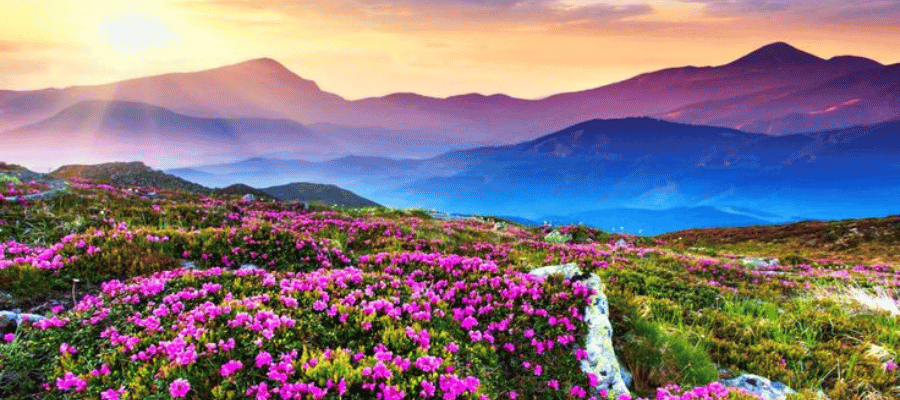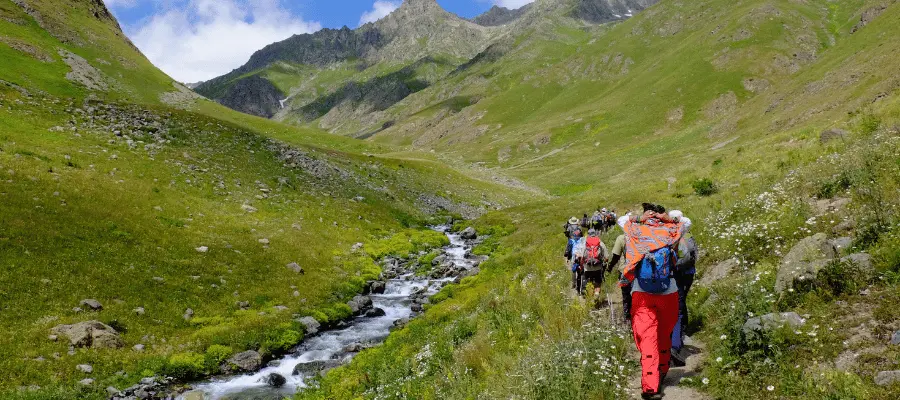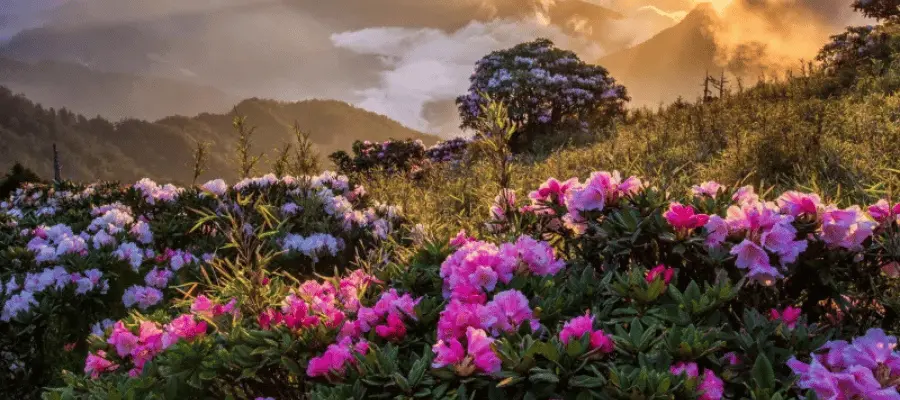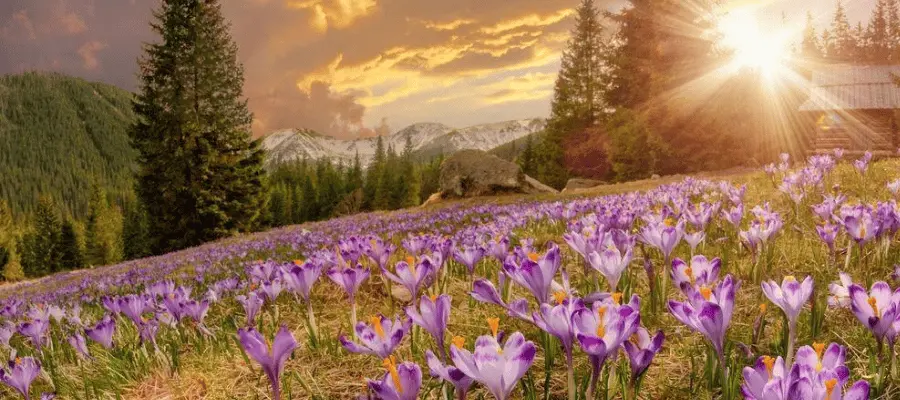
A Journey into Nature’s Paradise: Valley of Flowers Trek
Situated in the scenic state of Uttarakhand, one of India’s most exhilarating natural wonders is tucked away deep into the high Himalayas—Valley of Flowers National Park, Uttarakhand. Each year, thousands of adventure seekers and nature lovers around the world make to the Valley of Flowers trek to catch sight of beautiful wildflowers, glacial streams, and snow-covered peaks. A trek is more than just a trek. It’s a walk through a living masterpiece of nature.
The Allure of the Valley of Flowers

The Valley of Flowers National Park Uttarakhand is a UNESCO World Heritage site and probably the most bio diverse area in the Himalayas. This is located in Chamoli district at an altitude of about 3,600 meters above sea level, This valley becomes a floriferous bowl during monsoon months.
Thousands of species of wildflowers grace the landscape here, including blue poppies, Himalayan bellflowers, primulas and orchids, and so much more. But the blooming colors of the valley are a visual treat only rivaled by the valley’s peaceful environment, with butterflies fluttering in misty meadows and distant waterfalls tumbling over rocky cliffs.
However, the valley is not only about flowers. You can also see Himalayan wildlife, including the snow leopard, which is almost impossible to spot, musk deer, Himalayan monal, and the Asiatic black bear. This place is a haven for botanists, wildlife photographers, and eco tourists alike, with its rich flora and fauna.
Trekking to the Valley of Flowers

1. Reach Haridwar or Rishikesh (By Train/Bus/Air)
- Nearest Airport: Jolly Grant Airport, Dehradun (one hour approx. from Rishikesh)
- Rail Connectivity: Good connections exist from Delhi and other big cities of India
- Start your tour either from Haridwar or Rishikesh, as per your convenience.
2. Rishikesh to Govindghat (Drive – ~275 km / 10–11 hrs)
- Route: Rishikesh → Devprayag → Srinagar → Rudraprayag → Karnaprayag → Joshimath → Govindghat
- Long-distance road journey offering a scenic beauty through confluences of rivers like Alaknanda and Bhagirathi.
- Stay: Overnight stay at Govindghat (Altitude: 6,000 ft)
3. Govindghat to Ghangaria
- Mode: 4 km drive + 10 km trek
- Drive: From Govindghat to Pulna (4 km) by shared jeep/taxi
- Trek: Pulna → Ghangaria (10 km / 5–6 hours)
- The trail goes through green forests, waterfalls, and along the Lakshman Ganga rivers
- Stay: Overnight at Ghangaria (Altitude: 10,000 ft)
4. Ghangaria to Valley of Flowers
- Distance: 4 km one way trek
- Trek Time: 3–4 hours (depending on pace)
- No accommodation in the valley; hence, a day hike
- Explore the valley full of alpine flowers, rare plants, and wildlife like blue sheep and butterflies
- Return the same day to Ghangaria for overnight stay
5. Optional: Ghangaria to Hemkund Sahib (next day)
- Distance: 6 km (steep ascent)
- Trek Time: 6–7 hours round trip
- Visit the sacred Hemkund Sahib Gurudwara at 14,100 ft – one of the highest Gurudwaras in the world
6. Return Trek: Ghangaria → Govindghat → Rishikesh
- Day 1: Ghangaria → Pulna (10 km trek), drive to Govindghat
- Day 2: Drive back from Govindghat to Rishikesh/Haridwar (275 km / ~10 hrs)
The Valley of Flowers trek is a moderate one, ideal for first-time trekkers as well. Almost anyone can go on this amazing adventure with just some preparation and some basic fitness.
Best Time for Valley of Flowers Trek

When you’re planning your visit, timing is everything. The best time to visit Valley of Flowers Uttarakhand is from mid-July to mid-August. It’s when the valley is at its peak, thanks to the monsoon rains that brought life to the landscape and dissolved the snow that covered all the seeds under it.
Although the park actually opens in June and closes by late September, the beginnings and endings of the season are marked by their own type of beauty. Snow patches also appear in June, whereas September boasts clearer skies, fewer flowers, but a less crowded experience.
While, for those hoping to witness the valley in its most vibrant form, July and August are best months. However, remember this is also when the region receives the most rain, so you will need waterproof gear and some planning.
A Glimpse of the Chamoli Flower Valley

The Valley of Flowers is already present in the Chamoli Flower Valley region, itself a spiritual and scenic landmark. Apart from the valley, it has a sacred site for Sikhs—Hemkund Sahib— as well as several ancient temples strewn across the Garhwal Himalayas.
Many trekkers who make the journey to the valley of flowers also add a pilgrimage to Hemkund Sahib, at an even higher altitude, to their adventure.
Choosing a Valley of Flowers Uttarakhand Package
First-time travelers will see that planning the trek can be daunting. But if you are from places farther away, of course, and to save on bustle time, that’s where a Valley of Flowers Uttarakhand package will help. They normally include transport, meals, accommodation, permits, and guide service in one package, an easy and aided way to do the trek.
It doesn’t matter if you are traveling alone or in a group; selecting a good trekking operator can truly make or break your travel experience and keep you safe and comfortable on your way.
Tips for a Safe and Enjoyable Valley of Flowers Trek
- Acclimate Gradually: Don’t want to be overcome by altitude sickness? Well, spend a day or two in Govindghat or Ghangaria before proceeding upwards.
- Pack Smart: For essentials, add a raincoat, trekking shoes, warm clothing, sunscreen, and a water bottle.
- Stay Eco-Friendly: The valley is a protected area—bring your trash back, walk on marked trails, and don’t pick flowers.
- Listen to Your Guide: Weather conditions can change rapidly; Things can change very quickly weather wise and guides who know what they’re doing can help you get out of unknown situations.
- Stay Hydrated and Eat Well: Trekking at a high altitude is not easy, so make sure you keep yourself well fed and hydrated.
Conclusion
The whole Valley of Flowers trek is more than a scenic walk; it is a spiritual, emotional, and physical journey to one of nature’s most beautiful creations. In a few places do you have as magical and as rewarding an experience for those who seek peace, adventure, and inspiration.
Those who are fascinated with the vision of wandering through meadows of wildflowers while mountain tops are in sight should prepare before making a trekking plan in the Valley of Flowers Uttarakhand. This Himalayan paradise is best for anyone, whether you’re traveling solo or with a group, and will leave you in awe and drive you to return again and again.
Frequently Asked Questions About Valley of Flowers Trek
1. How difficult is the Valley of Flowers trek?
Trekking in the Valley of Flowers is regarded as easy to moderate. It’s perfect for beginners and doesn’t require any prior experience walking at high altitudes.
2. When does Valley of Flowers open and close?
Daily entry to the Valley of Flowers is permitted until 12:00 pm, with the doors opening at 7:00 am. By 4 p.m., you must depart from the valley. To pick up your ticket early and get in by 7:00 am, you should arrive at the entrance gate at 6:45 am.
3. What is the distance between Badrinath and Valley of Flowers?
Badrinath is 25 kilometers from the Valley of Flowers.
4. Is it safe for solo travelers to explore the Valley of Flowers?
Indeed, the Valley of Flowers trek is secure and appropriate for solo travelers, particularly in July and August when hiking is at its busiest. Better safety, assistance, and convenience are guaranteed when traveling with a guided group or choosing a Valley of Flowers Uttarakhand package, particularly for first-timers.
5. What is the total trekking distance for the Valley of Flowers trek?
The total distance of the Valley of Flowers hike is about 38 kilometers. This comprises:
- Ghangaria is 10 miles away from Pulna (one way).
- The Valley of Flowers is 4 km away from Ghangaria (one way).
Depending on how much of the valley you explore, the overall may vary significantly, but on the main hiking days, most trekkers walk between 10 and 12 km each day.
6. What is the distance between Ghangaria and Hemkund Sahib?
Although Hemkund Sahib is only 6 kilometers from Ghangaria, the climb to 14,100 feet is difficult and steep.


